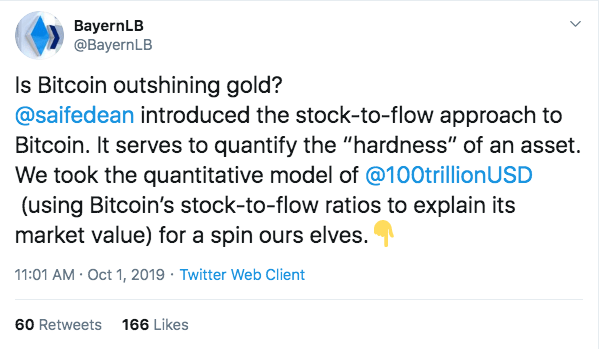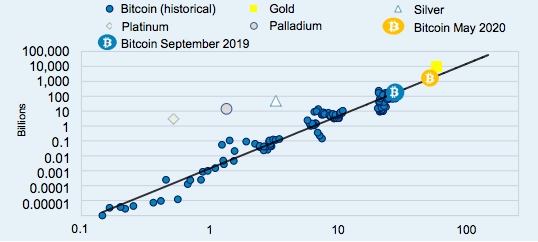
Bayern LB, one of Germany’s top banks, has published a report in strong support of bitcoin superseding gold, predicting a price of $90,000 per BTC post bitcoin’s halving in 2020.
Within a report entitled, “Is bitcoin outshining gold?” the bank’s researchers delved into the stock-to-flow ratios of gold and bitcoin, specifically regarding the impact of reduced supply on asset value.
The Stock-to-Flow Model
A stock-to-flow (SF) ratio is an analytical method commonly used within commodities, such as gold and silver, to ascertain the scarcity – or as the researchers put it the “hardness” – of an asset based on its circulating supply (stock) and annual production (flow). Essentially, the higher the SF of an asset, the more valuable it is deemed. The report remarks that when this analysis is applied to bitcoin, a “strong correlation” emerges between the market price and its SF.
This reaffirms the analyses of various crypto proponents, including Saifedean Ammous, the author of the seminal Bitcoin Standard, as well as PlanB, an analyst whose work on bitcoin’s stock-to-flow ratio has set a quasi-precedent.
In fact, Bayern LB, attributed their findings to both Ammous’ and PlanB, becoming so compelled they felt the need to test the method themselves:
Supply and Demand
According to the researchers, one of the reasons gold has stood in such high demand for so long is due to its scarcity. Gold, much like bitcoin, cannot be whimsically increased; moreover, gold yields a relatively limited annual production and already has a substantial foundation of supply. These two attributes make the yellow metal relatively impervious to dilution, gifting it with the current highest SF value of all commodities.
Interestingly, the report also suggests that SF acts as an attested judge of monetary utility:
The stock-to-flow ratio also serves as a quality criterion for monetary commodities. Historically speaking, it has invariably been the commodity with the highest stock-to-flow ratio at that juncture which has been used as money because this enabled the best value transfer over time.
On the Heels of Gold
So what does this all have to do with bitcoin? Well, to understand that we first have to look towards the 2020 bitcoin halving.
When creating bitcoin, Satoshi Nakamoto imposed a quasi-monetary policy to ensure that its circulating supply was limited and inflation was kept under check. This method included the requirement to half the mining reward for every 210,000 blocks mined – approximately every four years – until all blocks are mined.
The next block reward halving will land around May 2020, and thereafter bitcoin’s annual supply will decrease by half, generating only 6.25 BTC per block mined. This essentially has the same impact as doubling bitcoin’s SF. As such, researchers called Nakmoto’s implementation of the halving a “stroke of genius.”
“Bitcoin will probably already succeed in attaining a stock-to-flow ratio similarly high to that of gold in the coming year”
The chart denotes the SF ratios of bitcoin, gold, silver, platinum and palladium along the y-axis, with market cap along the x-axis. Researchers particularly highlight the tight correlation between bitcoin price history and it’s increasing SF:
As a result, the report suggests that bitcoin’s SF will go from a current ratio of 25.8 to around 53 post halving – placing it tantalizingly close to gold’s SF at 58.
“If the May 2020 stock-to-flow ratio for Bitcoin is factored into the model, a vertiginous price of around USD 90,000 emerges. This would imply that the forthcoming halving effect has hardly been priced into the current Bitcoin price of approximately USD 8,000 (the current model value is roughly USD 7,500).”
The report concludes with a caveat that even the most meticulous statistical model can “fail miserably when attempting to predict the future.” However, as the researchers note, the real test will be the 2020 halving.




